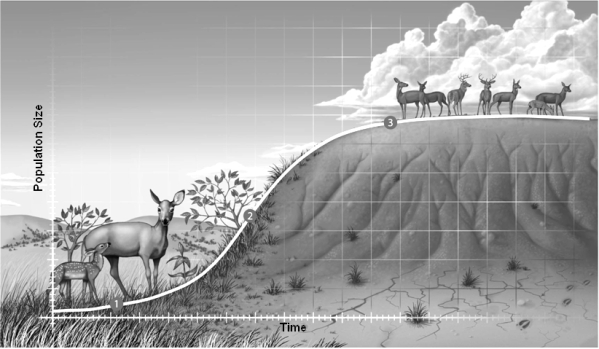Correct Answer

verified
Correct Answer
verified
Multiple Choice
Increasingly population density will most likely lead to which type of distribution pattern?
A) clumped
B) random
C) uniform
D) uniform and clumped
E) random and clumped
Correct Answer

verified
Correct Answer
verified
Multiple Choice
To a person studying utilization of classroom space on campus,the most useful data concerning students in a classroom would be expressed by the number of
A) total individuals.
B) individuals per square meter.
C) individuals per room.
D) rooms per building.
E) students of each age.
Correct Answer

verified
Correct Answer
verified
Essay
Classification.Answer the questions in reference to the seven terms listed below that are used by ecologists. a.density-dependent factor b.demographic transitional stage c.type I survivorship d.r-selected species e.biotic potential f.density-independent factor g.logistic growth -Clams,insects,many fish species fit into this model
Correct Answer

verified
Correct Answer
verified
Multiple Choice
In a population of Asian elephants,the death rate equals the birth rate.This population has
A) reached its biotic potential.
B) achieved zero population growth.
C) not exceeded its carrying capacity.
D) exponential growth.
E) geometric growth.
Correct Answer

verified
Correct Answer
verified
Multiple Choice
A J-shaped growth curve is converted to an S-shaped one
A) when the parents are past reproductive age.
B) if the data is plotted in reverse.
C) when the carrying capacity is reached.
D) if reproduction is stopped.
E) only for fast-growing populations such as bacteria.
Correct Answer

verified
Correct Answer
verified
Essay
Classification.Answer the questions in reference to the seven terms listed below that are used by ecologists. a.density-dependent factor b.demographic transitional stage c.type I survivorship d.r-selected species e.biotic potential f.density-independent factor g.logistic growth -Factors that affect the growth of a population regardless of the number of individuals in that population.
Correct Answer

verified
Correct Answer
verified
Multiple Choice
How much of Europe's population was wiped out by the Black Death?
A) 1/2
B) 1/3
C) 1/4
D) 1/5
E) 1/6
Correct Answer

verified
Correct Answer
verified
Multiple Choice
In Michigan,the population of Canada geese changed from 9,000 to a population of ___ in 2008.
A) 3,000
B) 30,000
C) 300,000
D) 3,000,000
E) 30,000,000
Correct Answer

verified
Correct Answer
verified
Multiple Choice
Limiting factors
A) produce more pronounced effects as a population grows.
B) prevent a population from producing a J-shaped curve.
C) can be either density-dependent or density-independent.
D) act together in concert to form the environmental resistance to population growth.
E) have all of these characteristics.
Correct Answer

verified
Correct Answer
verified
Multiple Choice
In itself,a flood that washes away an entire population of rabbits is
A) a density-dependent factor.
B) an intrinsic limiting factor.
C) density-independent.
D) a consequence of exponential growth.
E) an example of a population reaching its carrying capacity.
Correct Answer

verified
Correct Answer
verified
Multiple Choice
On Easter Island in the Pacific Ocean,from original population of 100 humans the population rose to around 3000.In time,the entire island was under cultivation and eventually the soils became so over cultivated that crops could no longer be grown.People started dying from starvation and disease.This Easter Island population had exceeded its
A) density-independent factors.
B) biotic potential.
C) logistic growth.
D) carrying capacity.
E) opportunistic life history.
Correct Answer

verified
Correct Answer
verified
Multiple Choice
Jellyfish are as likely to die at one age as any other.Thus,a type ___ survivorship curve characterizes their life history.
A) I
B) II
C) III
D) more than one of these
E) none of these
Correct Answer

verified
Correct Answer
verified
Multiple Choice
The most sustainable method for limiting human population growth is
A) decreasing birth rate.
B) increasing carrying capacity.
C) decreasing competition.
D) increasing death rate.
E) exploiting outer space.
Correct Answer

verified
Correct Answer
verified
Multiple Choice
Which of the following is NOT a density-dependent,growth-limiting factor?
A) pathogens
B) parasitism
C) drought
D) competition
E) species interaction
Correct Answer

verified
Correct Answer
verified
Multiple Choice
The exponential growth rate of a population under ideal conditions is its
A) carrying capacity.
B) logistic growth.
C) biotic potential.
D) realized niche.
E) density dependence.
Correct Answer

verified
Correct Answer
verified
Multiple Choice
What invention about 11,000 years ago led to a boom in the human population?
A) the wheel
B) agriculture
C) the printing press
D) the steam engine
E) all of these
Correct Answer

verified
Correct Answer
verified
Multiple Choice
If all diseases are eradicated and food supply exceeds demand indefinitely,the human population on the planet earth will NOT continue to grow at an exponential rate indefinitely because
A) a new disease organism will evolve.
B) density-independent factors will always remove individuals.
C) space will become a limiting factor.
D) the few humans left will engage in war and kill each other.
E) all of these will occur.
Correct Answer

verified
Correct Answer
verified
Multiple Choice
 Examine the figure above and answer the following question(s) .
-This figure describes a typical example of
Examine the figure above and answer the following question(s) .
-This figure describes a typical example of
A) biotic potential growth.
B) exponential growth.
C) logistic growth.
D) logarithmic growth.
E) density-dependent growth.
Correct Answer

verified
Correct Answer
verified
Multiple Choice
What percentage of married women worldwide use family planning methods?
A) 20
B) 30
C) 40
D) 50
E) 60
Correct Answer

verified
Correct Answer
verified
Showing 41 - 60 of 111
Related Exams